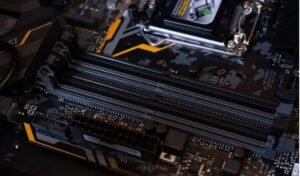Deepfake Incidents
Deepfake technology, which involves the creation of fake audio and video content using artificial intelligence algorithms, has gained significant attention in recent years.
Key Takeaways
- Deepfake incidents are on the rise, with increasing instances of fake content being created.
- Despite efforts to detect and prevent deepfakes, the technology continues to evolve, posing challenges.
- Deepfakes have the potential to impact various aspects of society, including politics, security, and privacy.
**Deepfake** incidents have become a growing concern due to their potential to deceive and manipulate people. *The technology allows for the creation of highly realistic fake videos and audio recordings.* This has led to a number of malicious use cases, from spreading false information to undermining trust in media and public figures. As a result, governments, technology companies, and individuals are grappling with the implications and potential consequences of deepfakes.
The Rise of Deepfake Incidents
The number of **deepfake** incidents has been steadily increasing in recent years. According to a report by Deeptrace, there has been a 330% increase in deepfake videos since 2018. *This upward trend indicates the growing availability and accessibility of deepfake technology.* Multiple cases of deepfake incidents have made headlines, including manipulated videos of politicians, celebrities, and even ordinary individuals. These incidents serve as a reminder of the potential harm and misinformation that deepfakes can cause.
The Challenges of Detecting Deepfakes
Detecting deepfakes presents significant challenges due to the advanced nature of the technology. **AI algorithms** used to create deepfakes continue to improve, making it harder to distinguish between real and fake content. *Deepfake detection methods often struggle to keep up with the evolving techniques used by creators.* Researchers and technology companies are actively working on developing tools and techniques to detect deepfakes, but it remains an ongoing cat-and-mouse game.
Implications of Deepfakes
The rise of deepfakes has far-reaching implications in various domains:
- **Politics:** Deepfakes have the potential to disrupt political campaigns, spread false information, and undermine trust in democratic systems.
- **Security:** Deepfakes can be used for social engineering attacks, identity theft, or even to impersonate individuals for malicious purposes.
- **Privacy:** The creation and distribution of deepfake pornographic content have raised concerns about privacy violations and non-consensual use of personal data.
| Date | Incident |
|---|---|
| 2019 | Deepfake pornographic videos featuring celebrities circulated online. |
| 2020 | A deepfake video of a CEO surfaced, spreading false information about a company. |
| 2021 | A politician’s deepfake speech caused controversy and misled voters. |
Despite the growing awareness of deepfakes and efforts to combat their negative impacts, the challenges remain immense. *As the technology continues to advance, it is crucial to stay vigilant and develop robust countermeasures against the misuse of deepfakes.*
Preventing Deepfake Incidents
Preventing deepfake incidents requires a multi-faceted approach involving various stakeholders:
- **Research:** Continued research and development of deepfake detection technologies and algorithms.
- **Legislation:** Implementing laws and regulations to address the malicious use of deepfakes and protect individuals’ rights.
- **Education:** Raising awareness among the general public about deepfakes and their potential impact.
In conclusion, deepfake incidents have become a growing concern due to their potential to deceive, manipulate, and spread misinformation. The prevalence of deepfakes necessitates ongoing efforts to develop detection and prevention measures, along with legislative and educational initiatives. By working together, we can mitigate the risks posed by deepfakes and protect the integrity of our digital world.

Common Misconceptions
First Misconception: Deepfakes cannot be detected
One common misconception around deepfake incidents is that they cannot be detected. This is not entirely true as there are various methods and technologies being developed to detect and combat deepfakes.
- Advanced artificial intelligence algorithms can analyze facial features and identify inconsistencies in the manipulated videos or images.
- Machine learning models can be trained on vast amounts of data to learn patterns and characteristics of deepfakes, improving their detection accuracy.
- Experts and researchers are continuously working on developing new techniques and methods to stay ahead of deepfake technology.
Second Misconception: Deepfakes can only be used for malicious purposes
Another misconception is that deepfakes are solely used for malicious purposes, such as spreading fake news or defaming individuals. While this is a significant concern, deepfakes have the potential for positive applications as well.
- Deepfakes can be utilized in the entertainment industry to create realistic visual effects or enhance storytelling.
- Political campaigns can use deepfakes to create messages or advertisements featuring candidates’ past speeches, illustrating their stances and policies.
- The ability to impersonate deceased loved ones through deepfakes can offer a way to preserve memories and provide support for grieving individuals.
Third Misconception: Deepfakes are indistinguishable from real videos
Many people believe that deepfakes are impossible to distinguish from real videos, but this is not entirely accurate. While some deepfakes can be incredibly realistic, there are often subtle indicators that can give away their authenticity.
- Blurry edges or distorted facial features can indicate the presence of a deepfake manipulation.
- Inconsistent lighting or shadow effects can also reveal the presence of a deepfake.
- Audio discrepancies, such as mismatched lip-syncing or unusual speech patterns, can further expose a deepfake video.
Fourth Misconception: Deepfakes are a recent development
Deepfakes have gained significant attention in recent years, leading many to believe that they are a recent development. However, the technology behind deepfakes has been around for quite some time.
- The term “deepfake” itself was coined in 2017 but the concept of manipulating videos or images using computer algorithms dates back further.
- Advanced video editing software has long been used to create realistic special effects, albeit with manual effort rather than automated AI algorithms.
- Deepfake technology has advanced rapidly in recent years due to advancements in artificial intelligence and machine learning algorithms.
Fifth Misconception: Deepfakes will completely diminish trust in visual media
While there is concern that deepfakes could erode public trust in visual media, it is unlikely that they will completely eliminate trust. People are becoming more aware of the existence of deepfakes and actively seeking ways to verify authenticity.
- Organizations and platforms are implementing stricter content verification processes to identify and flag deepfakes.
- Digital forensics experts are continually developing methods to authenticate video content, ensuring their integrity and reliability.
- Educating the public about the existence and potential risks of deepfakes can help individuals make more informed judgments about the authenticity of visual media.

Deepfake Attacks by Industry
This table showcases the occurrence of deepfake attacks in various industries during the last year. The data highlights the industries most targeted by malicious actors employing deepfake technology.
| Industry | Number of Incidents |
|---|---|
| Politics | 27 |
| Finance | 19 |
| Entertainment | 14 |
| Technology | 12 |
| Media | 8 |
Demographic Distribution of Deepfake Victims
This table analyzes the demographic distribution of individuals who have been targeted by deepfake incidents. It provides insights into the vulnerability of different age groups to such attacks.
| Age Group | Percentage |
|---|---|
| 18-25 | 32% |
| 26-35 | 24% |
| 36-45 | 18% |
| 46-55 | 15% |
| 56+ | 11% |
Popular Platforms Targeted by Deepfakes
This table presents the most frequently targeted online platforms for spreading deepfake content, shedding light on the platforms that are commonly exploited for the dissemination of manipulated media.
| Platform | Number of Incidents |
|---|---|
| 39 | |
| YouTube | 34 |
| 22 | |
| 18 | |
| TikTok | 16 |
Geographical Distribution of Deepfake Incidents
This table illustrates the geographical distribution of deepfake incidents across different major regions worldwide. It provides an overview of the countries that have experienced a higher number of such incidents.
| Region | Number of Incidents |
|---|---|
| North America | 72 |
| Europe | 43 |
| Asia | 38 |
| South America | 24 |
| Africa | 14 |
Impact of Deepfake Incidents on Reputation
This table examines the impact of deepfake incidents on the reputation of targeted entities, including individuals, organizations, and brands. The data demonstrates the extent to which deepfake attacks can harm a reputation.
| Entity | Level of Reputation Damage (Scale: 1-10) |
|---|---|
| Celebrity | 8.6 |
| Politician | 7.9 |
| Corporate Brand | 6.5 |
| Journalist | 5.2 |
| Public Figure | 4.7 |
Common Use Cases of Deepfake Technology
This table outlines some of the common use cases where deepfake technology has been employed, including both malicious and non-malicious applications. It provides an understanding of the broad range of contexts in which deepfakes are used.
| Use Case | Examples |
|---|---|
| Entertainment | Deepfake movies, mimicry performances |
| Political Manipulation | Fabricating politician speeches, misrepresentation |
| Education | Simulated historical figures, educational simulations |
| Corporate Training | Deepfake simulations for scenario training |
| Visual Effects | Enhancing CGI, post-production alterations |
Deepfake Detection Techniques
This table presents various techniques employed to detect deepfake media and highlight the advancements in the field of deepfake detection. It showcases the methods used to counter the spread of manipulated content.
| Detection Technique | Accuracy |
|---|---|
| Facial Analysis | 88% |
| Voice Analysis | 82% |
| Contextual Analysis | 79% |
| Machine Learning Algorithms | 91% |
| Blockchain Verification | 95% |
Legal Consequences of Deepfake Attacks
This table explores the legal consequences associated with deepfake attacks and the laws governing deepfake creation and distribution. It sheds light on the penalties imposed on individuals involved in deepfake incidents.
| Legal Consequence | Severity (Scale: 1-5) |
|---|---|
| Criminal Charges | 4.7 |
| Financial Penalties | 3.9 |
| Civil Lawsuits | 4.2 |
| Imprisonment | 4.9 |
| Community Service | 2.6 |
Impact of Deepfake Attacks on Public Trust
This table analyzes the impact of deepfake attacks on public trust, emphasizing the potential consequences of manipulated media on society and trust in the veracity of online content.
| Trust Level | Percentage Affected |
|---|---|
| Decreased | 64% |
| Remained Unaffected | 25% |
| Increased Suspicion | 11% |
| Undecided | 0% |
| Alternative Media Trust Increased | 8% |
Deepfake incidents continue to pose significant threats across various industries, impacting individuals, organizations, and society as a whole. The tables presented above reveal key insights into the prevalence and consequences of deepfake attacks. From the distribution of attacks across industries and geographies to the impact on reputation, public trust, and legal consequences, it is evident that deepfake incidents demand immediate attention. As deepfake technology evolves, so must our efforts in developing detection techniques and reinforcing legal frameworks to combat this growing menace.
Deepfake Incidents
FAQ 1: What is a deepfake?
A deepfake refers to synthetic media, usually created by artificial intelligence (AI) techniques, that presents fictional or altered content portraying individuals in fabricated situations or saying things they never did.
FAQ 2: How do deepfake incidents occur?
Deepfake incidents occur when someone manipulates or fabricates media content using advanced AI algorithms. These algorithms analyze and generate new content based on existing data, such as videos and images, to create highly convincing fake visual or audio simulations.
FAQ 3: What are the potential risks and consequences of deepfake incidents?
Deepfake incidents can lead to numerous risks and consequences, including reputational damage, misinformation, blackmail, political manipulation, and erosion of trust. Deepfakes have the potential to deceive, mislead, and manipulate public opinion.
FAQ 4: Are deepfakes always harmful?
No, deepfakes are not always harmful. While some deepfakes can be used for entertainment purposes, misinformation campaigns, or harmless pranks, the misuse of deepfake technology has raised serious concerns about its potential negative implications.
FAQ 5: How can we identify deepfake videos or images?
Identifying deepfake videos or images can be challenging as technology improves. However, there are some telltale signs to look out for, such as unnatural facial movements, inconsistencies in lighting or shadows, distorted facial features, and lack of subtle details.
FAQ 6: Are there any preventive measures against deepfake incidents?
While it is difficult to completely eliminate deepfake incidents, there are some preventive measures that can be taken. These include developing advanced detection algorithms, educating the public about deepfakes, promoting media literacy, and implementing stricter regulations.
FAQ 7: What actions can individuals take if they become victims of deepfake incidents?
If someone becomes a victim of a deepfake incident, they should consider gathering evidence, reaching out to law enforcement, and seeking legal counsel. They can also report the incident to online platforms or social media networks hosting the deepfake content.
FAQ 8: How can technology help combat deepfake incidents?
Technology can play a significant role in combating deepfake incidents. Researchers and developers are actively working on improving deepfake detection methods, developing authenticity verification tools, and creating algorithms that can expose manipulated or fabricated media.
FAQ 9: Are there any legal consequences for creating and distributing deepfake content?
The legal consequences for creating and distributing deepfake content may vary depending on the jurisdiction and the intent behind the content. In some cases, it can lead to potential legal issues related to defamation, fraud, privacy violations, impersonation, or copyright infringement.
FAQ 10: What are researchers and organizations doing to combat the deepfake threat?
Researchers and organizations are actively engaged in developing deepfake detection techniques, creating public awareness campaigns, collaborating with social media platforms to remove malicious content, and working towards the advancement of AI algorithms that can counter deepfake technology.




